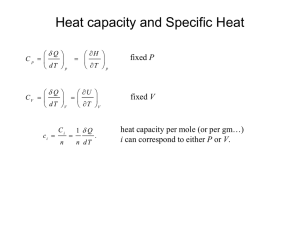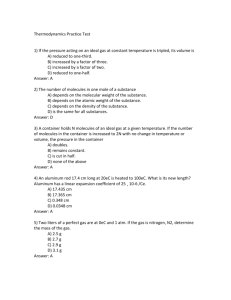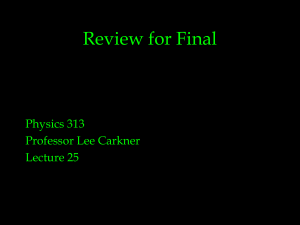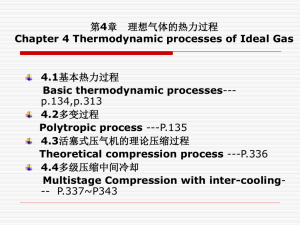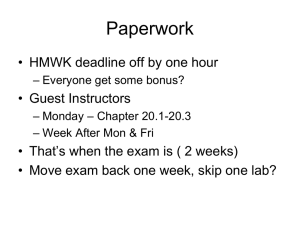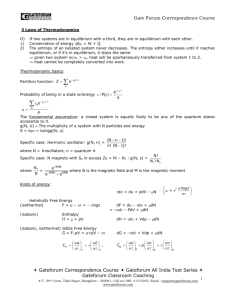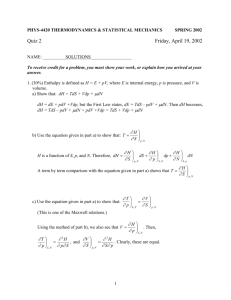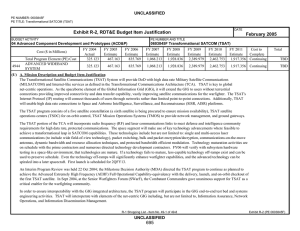click here for concept exam1 key
advertisement
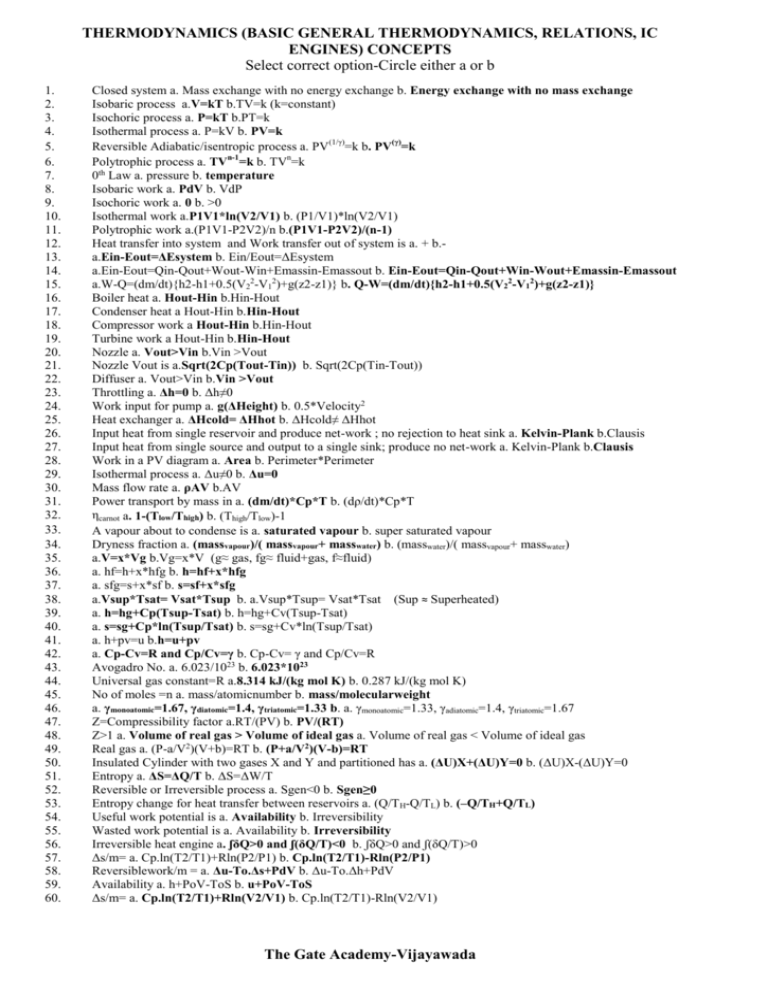
THERMODYNAMICS (BASIC GENERAL THERMODYNAMICS, RELATIONS, IC
ENGINES) CONCEPTS
Select correct option-Circle either a or b
1.
2.
3.
4.
5.
6.
7.
8.
9.
10.
11.
12.
13.
14.
15.
16.
17.
18.
19.
20.
21.
22.
23.
24.
25.
26.
27.
28.
29.
30.
31.
32.
33.
34.
35.
36.
37.
38.
39.
40.
41.
42.
43.
44.
45.
46.
47.
48.
49.
50.
51.
52.
53.
54.
55.
56.
57.
58.
59.
60.
Closed system a. Mass exchange with no energy exchange b. Energy exchange with no mass exchange
Isobaric process a.V=kT b.TV=k (k=constant)
Isochoric process a. P=kT b.PT=k
Isothermal process a. P=kV b. PV=k
(1/γ)
(γ)
Reversible Adiabatic/isentropic process a. PV =k b. PV =k
n-1
n
Polytrophic process a. TV =k b. TV =k
0th Law a. pressure b. temperature
Isobaric work a. PdV b. VdP
Isochoric work a. 0 b. >0
Isothermal work a.P1V1*ln(V2/V1) b. (P1/V1)*ln(V2/V1)
Polytrophic work a.(P1V1-P2V2)/n b.(P1V1-P2V2)/(n-1)
Heat transfer into system and Work transfer out of system is a. + b.a.Ein-Eout=ΔEsystem b. Ein/Eout=ΔEsystem
a.Ein-Eout=Qin-Qout+Wout-Win+Emassin-Emassout b. Ein-Eout=Qin-Qout+Win-Wout+Emassin-Emassout
a.W-Q=(dm/dt){h2-h1+0.5(V22-V12)+g(z2-z1)} b. Q-W=(dm/dt){h2-h1+0.5(V22-V12)+g(z2-z1)}
Boiler heat a. Hout-Hin b.Hin-Hout
Condenser heat a Hout-Hin b.Hin-Hout
Compressor work a Hout-Hin b.Hin-Hout
Turbine work a Hout-Hin b.Hin-Hout
Nozzle a. Vout>Vin b.Vin >Vout
Nozzle Vout is a.Sqrt(2Cp(Tout-Tin)) b. Sqrt(2Cp(Tin-Tout))
Diffuser a. Vout>Vin b.Vin >Vout
Throttling a. Δh=0 b. Δh≠0
Work input for pump a. g(ΔHeight) b. 0.5*Velocity2
Heat exchanger a. ΔHcold= ΔHhot b. ΔHcold≠ ΔHhot
Input heat from single reservoir and produce net-work ; no rejection to heat sink a. Kelvin-Plank b.Clausis
Input heat from single source and output to a single sink; produce no net-work a. Kelvin-Plank b.Clausis
Work in a PV diagram a. Area b. Perimeter*Perimeter
Isothermal process a. Δu≠0 b. Δu=0
Mass flow rate a. ρAV b.AV
Power transport by mass in a. (dm/dt)*Cp*T b. (dρ/dt)*Cp*T
ηcarnot a. 1-(Tlow/Thigh) b. (Thigh/Tlow)-1
A vapour about to condense is a. saturated vapour b. super saturated vapour
Dryness fraction a. (massvapour)/( massvapour+ masswater) b. (masswater)/( massvapour+ masswater)
a.V=x*Vg b.Vg=x*V (g≈ gas, fg≈ fluid+gas, f≈fluid)
a. hf=h+x*hfg b. h=hf+x*hfg
a. sfg=s+x*sf b. s=sf+x*sfg
a.Vsup*Tsat= Vsat*Tsup b. a.Vsup*Tsup= Vsat*Tsat (Sup ≈ Superheated)
a. h=hg+Cp(Tsup-Tsat) b. h=hg+Cv(Tsup-Tsat)
a. s=sg+Cp*ln(Tsup/Tsat) b. s=sg+Cv*ln(Tsup/Tsat)
a. h+pv=u b.h=u+pv
a. Cp-Cv=R and Cp/Cv=γ b. Cp-Cv= γ and Cp/Cv=R
Avogadro No. a. 6.023/1023 b. 6.023*1023
Universal gas constant=R a.8.314 kJ/(kg mol K) b. 0.287 kJ/(kg mol K)
No of moles =n a. mass/atomicnumber b. mass/molecularweight
a. γmonoatomic=1.67, γdiatomic=1.4, γtriatomic=1.33 b. a. γmonoatomic=1.33, γadiatomic=1.4, γtriatomic=1.67
Z=Compressibility factor a.RT/(PV) b. PV/(RT)
Z>1 a. Volume of real gas > Volume of ideal gas a. Volume of real gas < Volume of ideal gas
Real gas a. (P-a/V2)(V+b)=RT b. (P+a/V2)(V-b)=RT
Insulated Cylinder with two gases X and Y and partitioned has a. (ΔU)X+(ΔU)Y=0 b. (ΔU)X-(ΔU)Y=0
Entropy a. ΔS=ΔQ/T b. ΔS=ΔW/T
Reversible or Irreversible process a. Sgen<0 b. Sgen≥0
Entropy change for heat transfer between reservoirs a. (Q/T H-Q/TL) b. (–Q/TH+Q/TL)
Useful work potential is a. Availability b. Irreversibility
Wasted work potential is a. Availability b. Irreversibility
Irreversible heat engine a. ʃδQ>0 and ʃ(δQ/T)<0 b. ʃδQ>0 and ʃ(δQ/T)>0
Δs/m= a. Cp.ln(T2/T1)+Rln(P2/P1) b. Cp.ln(T2/T1)-Rln(P2/P1)
Reversiblework/m = a. Δu-To.Δs+PdV b. Δu-To.Δh+PdV
Availability a. h+PoV-ToS b. u+PoV-ToS
Δs/m= a. Cp.ln(T2/T1)+Rln(V2/V1) b. Cp.ln(T2/T1)-Rln(V2/V1)
The Gate Academy-Vijayawada
THERMODYNAMICS (BASIC GENERAL THERMODYNAMICS, RELATIONS, IC
ENGINES) CONCEPTS
Select correct option-Circle either a or b
61.
62.
63.
64.
65.
66.
67.
68.
69.
70.
71.
72.
73.
74.
75.
76.
77.
78.
79.
80.
81.
82.
83.
84.
85.
86.
87.
88.
89.
90.
91.
92.
93.
94.
95.
96.
97.
98.
99.
100.
101.
102.
103.
104.
105.
106.
107.
108.
109.
110.
111.
112.
113.
114.
115.
Rate of entropy generation (Irreversibility rate :pressure drop due to friction) a. mR(ΔP/P1) b. mR(ΔS/S1)
Availability (VdP)= a. (h1-h2)-To(s1-s2) b. (u1-u2)-To(s1-s2)
Irreversibility a. To ΔS b. To/ΔS
Reversible engine with 2 sources and1 sink a. (Q1/T1)+(Q2/T2)-(Q3/T3)=0 b. (Q1/T1)+(Q2/T2)+(Q3/T3)=0
Carnot Cycle a. 2 adiabatic and 2 isentropic b. 2 adiabatic and 2 isothermal
Stirling Cycle a. 2 isochoric and 2 isothermal b. 2 isochoric and 2 isentropic
Ericson Cycle a. 2 isochoric and 2 isentropic b. 2 isobaric and 2 isothermal
Reversible process a. dW=VdP and dQ=SdT b. dW=PdV and dQ=TdS
a. dU=TdS-PdV b. dU=TdS+PdV
a. dH=TdS-VdP b. dH=TdS+VdP
Helmholtz a. dA= -SdT-PdV b. dA= -SdT+PdV
Gibbs a. dG= -SdT+VdP b. dG= -SdT-VdP
a. (δT/ δV)S= -(δP/ δS)V b. (δT/ δV)T=-(δP/ δS)P
a. (δT/ δP)S= -(δV/ δS)P b. (δT/ δP)S= (δV/ δS)P
a. (δS/ δV)V= (δP/ δT)T b. (δS/ δV)T= (δP/ δT)V
a. (δS/ δP)T= -(δV/ δT)P b. (δS/ δP)P=(δV/ δT)V
Volume Expansivity a. β=( δV/ δT)*(1/V) b. β= -( δV/ δP)*(1/V)
Isothermal Compressibility a. α=( δV/ δT)*(1/V) b. α = -( δV/ δP)*(1/V)
a.Cp-Cv=(VT α 2)/ β b.Cp-Cv=(VT β2)/ α
a. Cp≥Cv b. Cv≥Cp
At Temperature =0 K a. Cp-Cv ≈ 1 b. Cp-Cv ≈ 0
Joule Thompson Coefficient a. μjt =(δT/ δP)h b. μjt =(δT/ δP)S
a. Cooling = μjt > 0, Warming = μjt < 0 b. Cooling = μjt < 0, Warming = μjt >0
a. μjt = [T(δv/ δT)P-v]/Cp b. μjt = [T(δv/ δT)P-v]/Cv
For IC engines a. Weight:Power is maximum a. Weight:Power is minimum
Piston rings are made of a. Steel b. Silicon Cast Iron
Bearings are made of a. White Metal b. Soft Grey Metal
Cylinder liners are made of a. Al -alloy steel b. Ni- alloy steel
Piston Swept Volume (Vs) a. Area*Length b. Perimeter2*Length
(Compression Ratio-1) a. Vs/Vc b. Vc/Vs
Volumetric Efficiency a. 4stroke>2stroke b. 4stroke<2stroke
4stroke has __;2stroke has ___ a. ports ; valves b. valves; ports
Thermal Efficiency a. Diesel> Petrol b. Diesel< Petrol
Indicated Thermal Efficiency a. IP/(mf*Lower Heat Calorific Value) b. IP/(mf*Higher Heat Calorific Value)
Brake Thermal Efficiency a. BP/(mf*Lower Heat Calorific Value) b. BP/(mf*Higher Heat Calorific Value)
Mechanical Efficiency a. IP/BP b. BP/IP
Volumetric Efficiency a. Swept.Vol/Act.Vol b. Act.Vol/Swept.Vol
Relative Efficiency a. Actual.Therm.η /Air.Std. η b. Air.Std. η / Actual.Therm. η
Brake Specific fuel Consumption & Ind. SFC a. mf/(BP-IP), mf/(IP-BP) b. mf/(BP), mf/(IP),
Single Cylinder-4 Stroke Ind.Mean.Eff.Pressure/60 a. (2*IP/(LAN)) b. (IP/(LAN))
Equivalence Ratio for rich mixture is Air Fuel Ratio a. Act/ Stoic b. Stoic/ Act
Equivalence Ratio for rich mixture is a.<1 b.>1
Otto Cycle a. Heat Addition and rejection @ Cv b. Heat Addition and rejection @ Cp
Otto Cycle Efficiency a. 1- [1/r(γ-1)] b. 1- [1/r(γ)]
Diesel Cycle a. Heat Addition @ Cv and rejection @ Cp b. Heat Addition @ Cp and rejection @ Cv
γ
Diesel Cycle Efficiency if {(ρ -1)/(ρ-1)} =c a. {1- [1/r(γ-1)]}*c b. {1- [1/r(γ-1)]}*(c/γ)
Diesel Cycle a. Cut-off Ratio = Comp.ratio/Expan.ratio b. Cut-off Ratio = Expan.ratio/Comp.ratio
Dual Cycle has a. 2 Cp and 1 Cv processes b. 2 Cv and 1 Cp processes
For Max.Pressure and Max.Temperature Efficiencies a. diesel>dual>otto b. diesel<dual<otto
Idling(I),Cruising(C),Max.Power(P),ColdStarting(S) |A/F ratios | a. S>P>I>C b. S>I>P>C
Mean Eff.Pressure a. (Work Done/Cycle)/ Swept Volume b. (Work Done/Cycle)/ Clearance Volume
Mass of Air Fuel Mixture if A/F is air fuel ratio a. (A-F) kg/kg of fuel b. (A+F) kg/kg of fuel
In 4stroke Swept Volume/second a. 0.8*D2*L* no.of cylinders*rpm/60 b. 0.8*D2*L* no.of cylinders*rpm/120
In 4Stroke no. of revolutions in one cycle a. 1 b.2
Torque in Nm, Power in kW is, N in rpm a. (2πNT/60000) b. (2πNT/60)
The Gate Academy-Vijayawada

